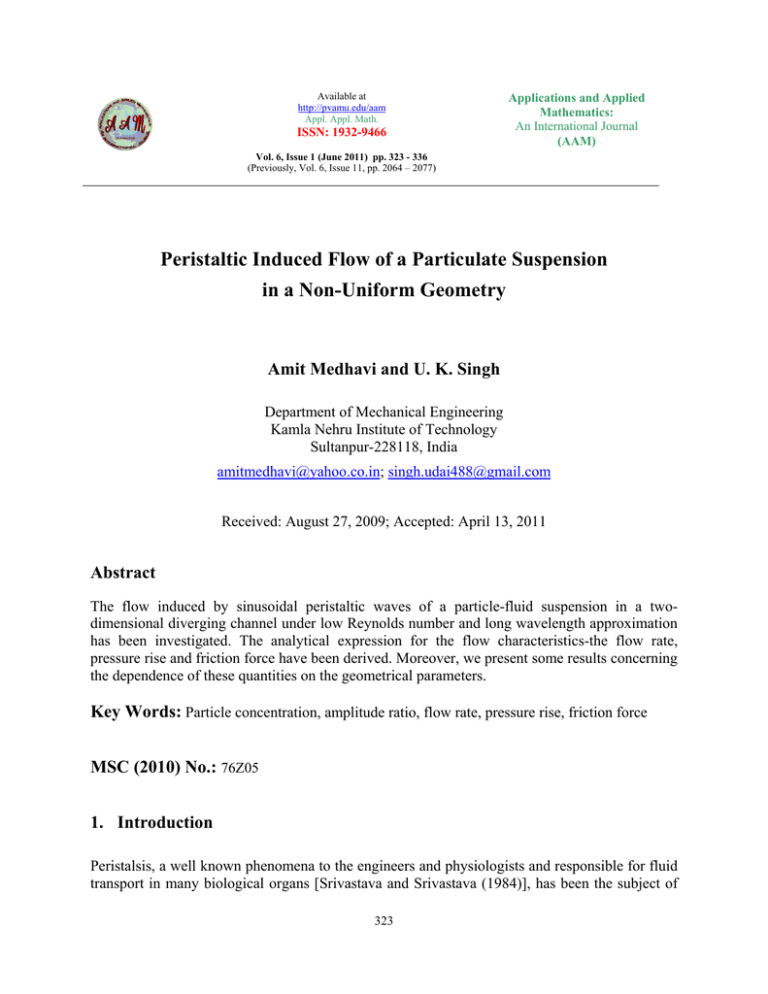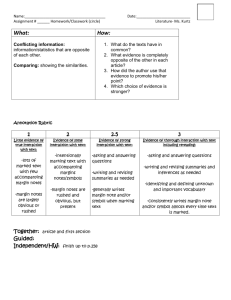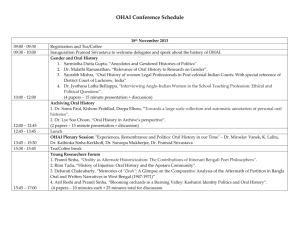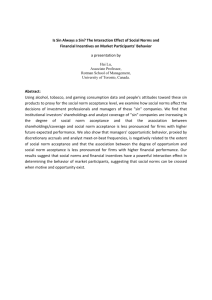Peristaltic Induced Flow of a Particulate Suspension in a Non-Uniform Geometry
advertisement

Available at http://pvamu.edu/aam Appl. Appl. Math. ISSN: 1932-9466 Applications and Applied Mathematics: An International Journal (AAM) Vol. 6, Issue 1 (June 2011) pp. 323 - 336 (Previously, Vol. 6, Issue 11, pp. 2064 – 2077) Peristaltic Induced Flow of a Particulate Suspension in a Non-Uniform Geometry Amit Medhavi and U. K. Singh Department of Mechanical Engineering Kamla Nehru Institute of Technology Sultanpur-228118, India amitmedhavi@yahoo.co.in; singh.udai488@gmail.com Received: August 27, 2009; Accepted: April 13, 2011 Abstract The flow induced by sinusoidal peristaltic waves of a particle-fluid suspension in a twodimensional diverging channel under low Reynolds number and long wavelength approximation has been investigated. The analytical expression for the flow characteristics-the flow rate, pressure rise and friction force have been derived. Moreover, we present some results concerning the dependence of these quantities on the geometrical parameters. Key Words: Particle concentration, amplitude ratio, flow rate, pressure rise, friction force MSC (2010) No.: 76Z05 1. Introduction Peristalsis, a well known phenomena to the engineers and physiologists and responsible for fluid transport in many biological organs [Srivastava and Srivastava (1984)], has been the subject of 323 324 Amit Medhavi and U.K. Singh scientific research for about four and half decades since the first investigation of Latham (1966). It is a form of fluid transport induced by a progressive wave of area contraction or expansion along the walls of a distensible duct containing a liquid or mixture. Besides its various engineering applications (e.g., heart-lung machines, finger and roller pumps, etc.), it is known to be a significant mechanism responsible for fluid transport in many biological organs including in swallowing food through esophagus, urine transport from kidney to bladder through the ureter, movement of chyme in gastrointestinal tract, transport of spermatozoa in the ductus efferentes of the male reproductive tracts and in cervical canal, in movement of ovum in the female fallopian tubes, transport of lymph in lymphatic vessels, and in the vasomotion of small blood vessels such as arterioles, venules and capillaries. Jaffrin and Shapiro (1971) explained the basic principles of peristaltic pumping in a twodimensional channel and brought out clearly the significance of the various parameters governing the flow. A review of most of the theoretical and experimental investigations reported up to the year 1994 has been presented in Srivastava and coworkers (1984, 1995). Important contributions beyond this, and of recent years, include the studies of Srivastava and Srivastava (1997), Mekheimer et al. (1998), Hakeem et al. (2002), Srivastava (2002), Misra and Pandey (2002), Hayat and coworkers (2002; 2006a,b; 2008), Mekheimer (2003), Misra and Rao (2004), Srivastava (2007a), Ali and Hayat (2008), Medhavi and coworker (2008a,b, 2010), and a few others. The theoretical study of particle-fluid mixture is very useful in understanding a number of diverse physical problems concerned with powder technology, fluidization, transport of solid particles in liquid and liquid slurries in chemical and nuclear processing, and metalized liquid fuel slurries for rocketry. The sedimentation of particles in a liquid is of interest in many chemical engineering processes, in medicine where erythrocytes sedimentation has become a standard clinical test, and in oceanography as well as in other fields. Recently, interest is developing in applying the particulate suspension theory to physiological flows as it provides improved understanding of the subjects such as diffusion of protein, the rheology of blood, the swimming of microorganism, the particle deposition on respiratory tract, etc. Peristaltic transport of a particle-fluid mixture has been studied by Hung and Brown (1976), Srivastava and Srivastava (1989, 1997), Mekheimer et al. (1998), Srivastava (2002), Medhavi and Singh (2008b), and a few others. Barring a few [Gupta and Seshadri (1976); Srivastava and coworkers (1982, 1983, 1985, 1988); Mekheimer (2002); etc.)], most of the studies in the literature have been conducted in uniform geometry whereas it is known that in most of the practical applications, particularly, in physiological flows, the flow geometry is found to be nonuniform. With increasing interest in particulate suspension flow due to its direct applications to diverse physical problems, the present investigation is devoted to study the flow of a particlefluid mixture in a non-uniform channel induced by sinusoidal peristaltic waves. In view of the theoretical model for blood flow proposed in Srivastava and Srivastava (1983) and discussed briefly in Srivastava and coworker (2007b, 2009), it is believed that the theoretical study presented here may be applied to study the peristaltic induced flow of blood in small vessels with varying cross-section. AAM: Intern. J., Vol. 6, Issue 1 (June 2011) [Previously, Vol. 6, Issue 11, pp. 2064 – 2077] 325 Figure 1. Peristaltic pumping in a diverging channel 2. Formulation of the Problem Consider the flow of a particulate suspension through a two-dimensional channel of non-uniform width with a sinusoidal wave traveling down its wall. The geometry of the wall surface is described as (Figure 1) H(x,t) = d(x) + b sin 2 (x - ct) , (1) with d(x) = do + k x , (2) where d(x) is the half width of the channel at any axial distance x from inlet, do is the half width of the channel at inlet, k (<<1) is a constant whose magnitude depends on the length of the channel and exit and inlet dimensions, b is the amplitude of the wave, is the wavelength, c is the wave propagation velocity and t is the time. We introduce the following dimensionless variables as x’= x/ , y’=y/do, t’=ct/ , (u’f, u’p) = ( u f ,u p )/c, (v’f, v’p) = ( v f , v p )/cdo, p’=pd 2o / cμ o , μ μs /μo , S’ =S d o2 /μo , where (x, y) are Cartesian coordinates with x measured in the direction of the wave and y measured in the direction normal to the mean position of the channel walls; (u f ,v f ) denotes the fluid phase and ( u p , v p ) particle phase velocity components along (x, y) directions respectively; f , p be the actual densities of the material constituting fluid and particulate phases respectively; (1-C) f is the fluid phase density, C f the particulate phase density; p denotes the pressure and C denotes the volume fraction of the particles; s (C) s is the suspension viscosity and S being the drag coefficient of interaction for the force exerted by one phase on the 326 Amit Medhavi and U.K. Singh other. The limitations of present theoretical model are well stated in Srivastava and coworkers (1983, 2009). An applications of the above mentioned non-dimensional variables and using a continuum approach, the equations governing the linear momentum and the mass for both the fluid and particle phases [Srivastava and Srivastava (1989)] after dropping the primes, are obtained as u f u f u (1-C) Re f u f vf = - (1-C) x y t 2u f 2u f p (1 C ) 2 + CS ( u p u f ), 2 2 x y x v f v f v (1-C) 3 Re f u f vf =-(1-C) x y t 2v f 2v f p (1 C ) 2 2 + C S 2 ( v p v f ), 2 2 y x y (1 C ) u f (1 C ) v f 0 , x y (3) (4) (5) u p u p u p C S ( u f u p ), C (ρ f /ρ p ) δ Re p u p vp =-C x x y t (6) v v v p C S 2 ( v f v p ), C (ρ f /ρ p ) δ 3 Re p u p p v p p = - C y x y t (7) C up C vp 0 , x y (8) R e = c ρ f do /μo and δ d o /λ are Reynolds number and the wave number respectively. The empirical relation for the viscosity of suspension, s and the expression for the drag coefficient of interaction, S are selected as [Srivastava and Srivastava (1989); Srivastava (2007b)] s (C)= o / (1–mC), m = 0.070 exp [2.49C+ (1107/T) exp (-1.69C)], (9) AAM: Intern. J., Vol. 6, Issue 1 (June 2011) [Previously, Vol. 6, Issue 11, pp. 2064 – 2077] 327 9 o S= 2 ao2 4 3 [8 C 3 C 2 ] 1 / 2 3 C , (2 3 C ) 2 (10) where o is the fluid viscosity (suspending medium), ao is the radius of a particle and T is measured in absolute temperature (oK). The viscosity of the suspension expressed by the formula (9) is found to be reasonably accurate up to C=0.6 (i.e., 60% hematocrit in the case of blood). Jaffrin and Shapiro (1971) observed that the Reynolds number is quite small when the wavelength is large, and therefore, the inertial convective acceleration terms may be neglected in comparison to viscous terms. Under the long wavelength approximation of Jaffrin and Shapiro (1971), the equations (3)-(8) governing the flow in its non-dimensional form in the laboratory frame of reference reduce to (1-C) d 2u f dp (1 C ) C S (u p u f ), dx dy 2 (11) dp C S (u f u p ) , dx (12) C The non-dimensional boundary conditions are uf = 0 , at u f y u p y y = h = H/d o = 1+ 0 at kx + sin 2 (x-t), do y 0. (13) (14) with b / do . The boundary conditions given in equations (13) and (14) are respectively standard no-slip condition at the channel walls and the symmetric condition at the axis. 3. Analysis The expressions for the velocity profiles, uf and up, obtained as the solution of the equations (11) and (12) subject to the boundary conditions (13) and (14) are given as uf 1 dp 2 (h y 2 ) , 2 (1 C ) dx (15) 328 Amit Medhavi and U.K. Singh up 1 2 (1 C ) dp 2 2 h y , 2 (1 C ) dx S (16) The flow flux, q(x, t) is now calculated as h q (x, t) = 1 C u f C u p dy = - o 1 dp 3 3 C (1 C ) h , h 3 (1 C ) dx S (17) or - dp 3 (1 C ) q ( x, t ) = , dx h3 h (18) with = 3 C (1 C ) / S , a non-dimensional suspension parameter. The pressure rise p L (t ) and the friction force at the wall, F L (t ) in the channel of length L in their non-dimensional form are obtained as L/ pL (t ) = o L/ FL (t ) = o dp dx = 3 (1 C ) dx L/ o dp h dx = 3 (1 C ) dx q ( x, t ) dx, h (h 2 ) L/ o q ( x, t ) h2 . (19) (20) AAM: Intern. J., Vol. 6, Issue 1 (June 2011) [Previously, Vol. 6, Issue 11, pp. 2064 – 2077] 329 Setting k = 0 in equations (19) and (20), one obtains the expressions for pressure rise and friction force for a particle-fluid suspension in a uniform channel. In the absence of the particulate phase (i.e., C = 0), the expressions given in equations (19) and (20) reduce to the results obtained in Gupta and Seshadri (1976) for a Newtonian fluid in a non-uniform channel. Also, with k = 0 and C = 0 in equations (19) and (20), one derives the results obtained in Jaffrin and Shapiro (1971) in the laboratory frame of reference. 4. Results and Discussion Computer codes are now developed to evaluate the analytical results obtained in equations (19) and (20) at the temperature of 25.5o C in order to observe the quantitative effects of the various parameters on the flow characteristics-the pressure rise and the friction force. We assume the form of instantaneous flow rate q(x, t), periodic in (x-t) as [Gupta and Seshadri (1976)] q (x, t) = Q + sin 2 (x-t) , (22) where Q is the time average of the flow over one period of the wave. This form of q(x, t) has been assumed in view of the fact that the constant value of q(x, t) gives pL (t ) always negative and hence there will be no pumping action. Using the form of q(x, t) given in equation (22), we compute the dimensionless pressure rise pL (t ) and friction for FL (t ) over the channel length for various values of the dimensionless flow average Q, amplitude ratio and particle concentration, C. The average pressure rise pL and the friction force FL are then evaluated by averaging pL (t ) and FL (t ) , respectively, over one period of wave. Some of the critical results are displayed graphically in Figures 2-11. The various parameters values selected [Srivastava and Srivastava (1984); Mekheimer (2002)] are d o = 0.01 cm, L = = 10 cm, k= 0.5 d o = 0.0005. L For any given flow rate Q, the pressure rise, Δp L (t ) (hereafter denoted by Δp ) increases with particle concentration, C but for a given particle concentration, C the pressure rise, Δp decreases with increasing flow rate, Q (Figure 2). The flow characteristic, Δp assumes much smaller magnitude in non-uniform channel than its corresponding magnitude in the uniform channel (Figures 2 and 3). The average pressure rise pL versus time average flow rate, Q has been plotted in Figure 4 in a non-uniform channel which indicates a linear relationship between pL and Q and thus the maximum flow rate is achieved at zero pressure rise and maximum pressure occurs at zero flow rate. The flow characteristic, pL is found to be indefinitely increasing with increasing amplitude ratio, for any given flow rate, Q and the particle 330 Amit Medhavi and U.K. Singh concentration C (Figure 5). The magnitude of pL assumes a very high asymptotic value at about = 0.6 in both the uniform and non-uniform channels (Figures 5 and 6). =0.7 Numbers ________ C=0.0 0.01 ------------- C=0..4 ................ C=0.6 0 .4 0.00 .6 -0.01 pL -0.02 -0.03 0.0 0.2 0.4 0.6 0.8 Q 1.0 1.2 1.4 1.6 Fig.4 Pressure-flow rate relationship for different and C in a non-unioform channel. 1.8 AAM: Intern. J., Vol. 6, Issue 1 (June 2011) [Previously, Vol. 6, Issue 11, pp. 2064 – 2077] 331 0.006 Numbers Q ________ C= 0.0 -.-.-.-.-.-.-. C= 0.2 ------------- C= 0.4 ................ C= 0.6 0.004 0.0 0.002 p L 0.1 0.000 -0.002 0.3 -0.004 0.0 0.1 0.2 0.3 0.4 0.3 0.4 0.5 Fig. 5 Variation of pressure rise, pL with amplitude ratio, for different Q and C non-uniform channel. 0.6 0.05 Numbers Q ________ C= 0.0 -.-.-.-.-.-.-. C= 0.2 ------------- C= 0.4 ................ C= 0.6 0.04 0.03 pL 0.02 0.01 0 0.00 .1 .3 -0.01 0.0 0.1 0.2 0.5 0.6 Fig. 6 Variation of pressure rise, pL with amplitude ratio, for different Q and C uniform channel. However, as expected pL assumes reasonably smaller value in non-uniform channel than its corresponding magnitude in uniform channel. The average pressure rise, pL versus C has been displayed in Figures 7 and 8 for non-uniform and uniform channels, respectively. The flow characteristic, pL increases with C at zero flow rate for any given amplitude ratio, , however, 332 Amit Medhavi and U.K. Singh the nature in the variation of pL with C is highly influenced with decreasing values of the amplitude ratio, for any given non-zero value of the average flow rate, Q. It is noticed that for any given flow rate, Q, the flow characteristic, pL increases with amplitude ratio, (Figures 7 and 8). For any particle concentration, C the friction force, FL (t ) increases with flow rate, Q but decreases with increasing particle concentration, C for a given flow rate, Q (Figure 9). The flow characteristic, FL (t ) assumes higher magnitude in uniform channel than its corresponding magnitude in non-uniform channel (Figures 9 and 10). One notices that the average friction force FL increases with the flow rate, Q for any given particle concentration, C and the amplitude ratio, retaining the linear relationships between the average friction force FL and the flow rate, Q (Figure11).The inspection of Figures 2 and 9 reveals that the flow characteristics, FL (t ) possesses characteristics opposite to that of the pressure rise, Δp for any given set of the parameters. The similar conclusion may be drawn in the case of their averaged values, FL and pL from Figures 4 and 11. 0.010 0.008 0.006 Numbers Q ________ = 0.0 -.-.-.-.-.-.-. = 0.2 ------------- = 0.4 ................ = 0.6 0 .1 0.004 pL 0.002 0 0 .1 0.000 .1 .1 -0.002 .3 -0.004 0.0 0.1 0.2 0.3 C 0.4 0.5 0.6 Fig. 7 Variation of pressure rise, pL with particle concentration, C for different Q and non-uniform channel. AAM: Intern. J., Vol. 6, Issue 1 (June 2011) [Previously, Vol. 6, Issue 11, pp. 2064 – 2077] 333 0.06 Numbers Q ________ = 0.0 0.05 -.-.-.-.-.-.-. = 0.2 ------------- = 0.4 ................ = 0.6 0 0.04 .1 0.03 pL 0.02 .3 0.01 0 0.00 0 .1 .1 .3 -0.01 0.0 0.1 0.2 0.3 0.4 C 0.5 0.6 Fig. 8 Variation of pressure rise, pL with particle concentration, C for different Q and uniform channel. 0.0 .3 -0.5 -1.0 .1 -1.5 -2.0 FL(t) 0 -2.5 =0.7 Numbers Q ________ C=0.0 -3.0 -3.5 ------------- C=0.4 ................ C=0.6 -4.0 -4.5 0.0 0.2 0.4 t 0.6 0.8 Fig. 9 Variation of friction force, FL(t) with time, t for different Q and C in a non-uniform channel 1.0 334 Amit Medhavi and U.K. Singh -1.5 -2.0 ________ = 0.7 -2.5 ------------- C=0.4 ................ C=0.6 Numbers Q -3.0 .3 C=0.0 FL(t) -3.5 .1 0 -4.0 -4.5 0 -5.0 -5.5 0.0 0.2 0.4 t 0.6 0.8 1.0 Fig. 10 Variation of friction force, FL(t) with time, t for different Q and C in a non-uniform channel 0.03 Numbers ________ C=0.0 0.02 ------------- C=0.4 ................ C=0.6 FL 0.01 0 0.00 .4 .6 -0.01 0.0 0.2 0.4 0.6 0.8 Q 1.0 1.2 1.4 1.6 1.8 Fig.11 Friction force-flow rate relationship for different and C in a non-unioform channel. AAM: Intern. J., Vol. 6, Issue 1 (June 2011) [Previously, Vol. 6, Issue 11, pp. 2064 – 2077] 335 REFERENCES Ali, N. and Hayat, T. (2008). Effects of an endoscope on peristaltic flow of a micropolar fluid. Mathematical and Computer Modeling 48, pp.721-733. Gupta, B. B. and Seshadri, V. (1976). Peristaltic pumping in non-uniform tubes. J. Biomech. 9, pp.105-109. Hakeem, A.E., Naby, A.E. and Misery, A.M.E. (2002). Effects of an endoscope and generalized Newtonian fluid on peristaltic motion. Appl. Math. & Comput. 128, pp.19-35. Hayat, T. and Ali, N. (2006a). On mechanism of peristaltic flows for power-law fluid. Physica Acta 371, 188-194. Hayat, T. and Ali, N. (2006b). Peristaltic induced motion of a MHD third grade fluid- in a deformable tube. Physica Acta 370, pp.225-239. Hayat, T., and Ali, N. (2008).Slip effects on peristaltic transport of MHD fluid with variable viscosity. Physics Letters A 372, pp.1477-1489. Hayat, T., Wang, Y., Siddiqui, A.M. and Hutter, K. (2002). Peristaltic motion of a third order fluid in a circular cylindrical tube. Mathematical Models and Methods in Applied Sciences 12, pp.1671-1706. Hung, T.K. and Brown, T. D. (1976). Solid particle motion in a two-dimensional peristaltic flows. J. Fluid Mech. 73, pp.77-96. Jaffrin, M. Y. and Shapiro, A. H. (1971). Peristaltic pumping. Ann. Rev. Fluid Mech. 3, pp.1336. Latham, T. W. (1966). Fluid Motion in Peristaltic Pump. M.S. Thesis, M.I.T. Cambridge. Medhavi, A. and Singh, U. K. (2008a). A two-layered suspension flow induced by peristaltic waves. Int. J. Fluid Mech. Res. 35, pp.258-272. Medhavi, A. (2008b). Peristaltic pumping of a non-Newtonian fluid. Applic. and Appl. Math. 3, pp.137-148. Medhavi, Amit (2010). Peristaltic pumping of a particulate suspension in a catheterized tube. EJournal of Sci. and Tech. 5, 77-93. Mekheimer, Kh. S. (2003). Nonlinear peristaltic transport through a porous medium in an inclined planner channel. Journal of Porous Media 6, pp. 189-201. Mekheimer, Kh. S. (2002). Peristaltic transport of a couple stress fluid in a uniform and nonuniform channels. Biorheol. 39, pp.755-765. MeKheimer, Kh. S., El-Shehawey, F.E. and Elaw, A.A. (1998). Peristaltic motion of a particlefluid suspension in a planar channel. Int. J. Theo. Phys. 37, pp.2895- 2920. Misra, J. C. and Pandey, S. K. (2002). Peristaltic transport of blood in small vessels: study of a mathematical model. Computers and Mathematics with Applications 43, pp.1183-1193. Misra, M. and Rao, A. R. (2004). Peristaltic transport of a Newtonian fluid in an asymmetric channel. ZAMP 54, pp. 532-550. Srivastava, L.M. and Srivastava, V.P. (1983). On two phase model of pulsatile blood flow with entrance effects. Biorheol. 20, pp. 761-777. Srivastava, L.M. and Srivastava, V.P. (1989). Peristaltic transport of a particle-fluid suspension. Trans. ASME J. Biomech. Engng. 111, 157-165. 336 Amit Medhavi and U.K. Singh Srivastava, L.M. and Srivastava, V.P. (1982). Peristaltic transport of a two-layered model of physiological fluid. J. Biomech. 15, pp. 257-265. Srivastava, L.M. and Srivastava, V.P. (1985). Peristaltic transport of a non-Newtonian fluid. Annals of Biomed. Engng. 13, pp. 137-153. Srivastava, L.M. and Srivastava, V.P. (1988). Peristaltic transport of a power-law fluid. Rheol. Acta 27, pp. 428-433. Srivastava, L.M. and Srivastava, V.P. (1984). Peristaltic transport of blood: Casson model II. J. Biomech. 17, pp. 821-829. Srivastava, L.M., Srivastava, V.P. and Sinha, S.N. (1983). Peristaltic transport of a physiological fluid. Part I, II & III. Biorheol. 20, pp. 153-185. Srivastava, V. P. (2007a). Effects of an inserted endoscope on chyme movement in small intestine. Applications and Appl. Math., 2, pp. 79-91. Srivastava, V.P. (2007b). A Theoretical model for Blood Flow in Small Vessels. Applications and Applied Mathematics 2, pp. 51-65. Srivastava, V.P. and Saxena, M. (1995). A Two-fluid model of non-Newtonian blood flow induced by peristaltic waves. Rheol. Acta 34, pp. 406-414. Srivastava, V.P. and Srivastava, L.M. (1997). Influence of wall elasticity and Poiseuille flow on peristaltic induced flow of a particle-fluid mixture. Int. J. Engng. Sci. 35, pp. 1359-1361. Srivastava, V.P. and Srivastava, Rashmi (2009). Particulate suspension blood flow through a narrow catheterized artery. Comput. Math. Applic.58, pp. 227-234. Srivastava, V.P. (2002). Particle-fluid suspension flow induced by peristaltic waves in a circular cylindrical tube. Bull. Cal. Math. Soc. 94, pp. 167-184.





